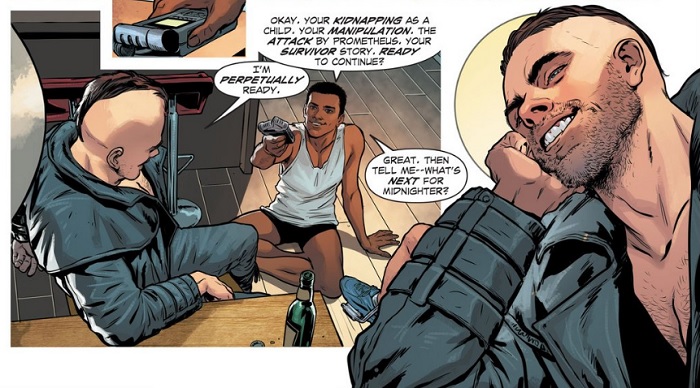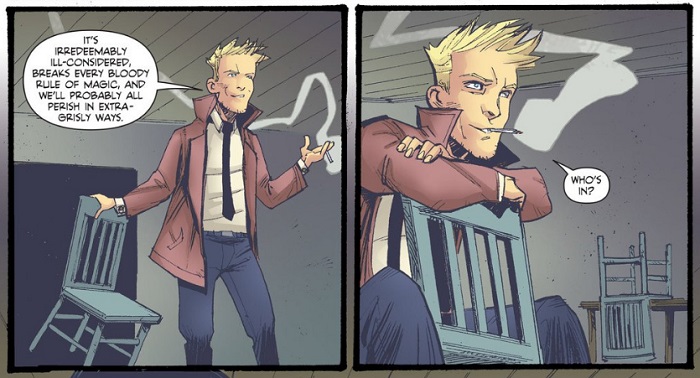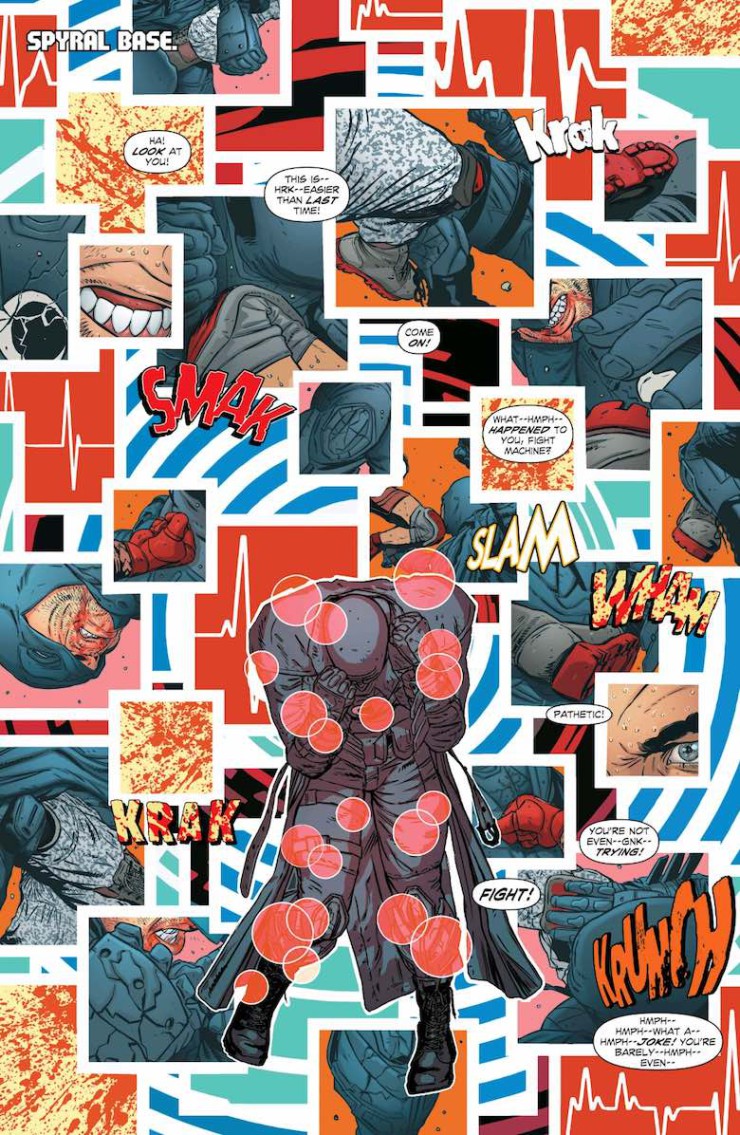June is Pride Month, but you wouldn’t know it if DC anything to go by. This month marks the end of the publisher’s only titles headlined by queer characters: Constantine: The Hellblazer, Midnighter, and Harley Quinn. To make matters worse, once the “Rebirth” faff is done and dusted, only two queer characters, Harley and Constantine, will have a solo series, and we’ll have to wait until August for those. While there’s a new crop of characters of the LGBTQ variety coming up, most are being relegated to minor roles or team members. DC actually has a pretty decent back catalogue of LGBTQ+ characters to choose from, but it’s like DC has either forgotten they exist or simply don’t care.
Think I’m over reacting? Earlier this month DC released a promo image for “Rebirth” featuring nearly 70 characters from the relaunch. Of those who made the cut, Batwoman is squeezed in between Batman and Superman’s thighs, and Harley and Constantine—both of whom are getting solo titles—are buried at the bottom of the image. (Midnighter is completely absent despite guesting in Nightwing.) Harley Quinn is the best selling female—and queer female—comic book character in DC history; she deserves a prominent feature, not as some teensy, easily overlooked background filler.
Look, I get it. There’s a lot to be pissed off about with “Rebirth,” not to mention with DC’s shoddy treatment of its queer characters. DC may have no interest in holding onto small sellers like Constantine: The Hellblazer and Midnighter, but that doesn’t mean we have to let them go. If you haven’t been reading these titles—and given their low sales, you haven’t—come see all the awesomeness you’ve been missing out on.
Origin Stories
Constantine: The Hellblazer
When someone starts killing ghosts, foul-mouthed, chain-smoking John Constantine reluctantly takes the case. He ditches New York for London to hunt spirits. Meanwhile demonic business dealings are taking place that will have grave consequences for both the magical and mundane worlds. Constantine falls a little in love and soon regrets it when the evils of his past crawl out of the depths of Hell to wreak havoc on New York City.
Written by Ming Doyle and James Tynion IV, Constantine: The Hellblazer released 13 issues between June 2015 and June 2016. Series artists and colorists varied by issue, but most of the artwork was handled by Riley Rossmo and colorist Ivan Plascencia. Letterer Tom Napolitano was a constant throughout. Tynion is moving to Detective Comics, but Doyle is at present not involved with “Rebirth.”
Midnighter
Midnighter is a superhuman with enhanced strength, a supercomputer for a brain, and the ability to predict all the possible outcomes of a fight before the fight even begins. And now that he and Apollo have split up, he’s also single and ready to mingle. The main arc is about tracking down the thief who stole valuable tech from the God Garden and used it to create a menace even more powerful than Midnighter, but the real meat of the plot is about Midnighter coming to terms with his traumatic past and discovering what kind of man he really is.
Midnighter was written by Steve Orlando, with art by ACO and Hugo Petrus, colors by Romulo Fajardo Jr., and letters by Jared K. Fletcher. The series debuted in 2015 and ran for 12 issues, the most recent of which released May 4, 2016. Orlando is now working on the new Supergirl book.
To Pull Or Not To Pull

Part of what makes Constantine so interesting to read is that he’s constantly having to face up to the consequences of his actions. Too often heroes blaze away with little regard for those who get trampled beneath them (see the season finales of Arrow and The Flash for recent, frustrating examples). Constantine is self-serving, selfish, cocky, and brazen, but he can’t escape the repercussions of his choices. If he’s lucky enough to not have to witness the ensuing carnage then he’s wracked with guilt over those caught in the wake of his behavior…but only up to a point. He’s not above abandoning others to clean up his mess if it means getting out before the consequences catch up with him.
The plight of the dead ghosts and the magical community in New York and the suffering of the innocents he dragged into his darkness haunts him so much he plays dice with the souls of every New Yorker. He’ll work a case because it’s the right thing to do even if he drags his feet the entire time, but what really fires him up is injustice against the undeserving and unprotected. Like Midnighter, Constantine is a morally gray anti-hero. He does good things but not necessarily out of the kindness of his heart. This iteration of Constantine isn’t as vicious or grim as Alan Moore’s—really, he’s closer to the TV version but a splash bloodier—but he’s just as damaged and damaging as his fractured relationship with hunky Oliver demonstrates.
Constantine: The Hellblazer isn’t nearly as strong a book as it should be, but it’s still a great read. Doyle and Tynion’s story is a little too weak and plothole-y in places, with some B-plots getting rushed through and the main arcs missing some key beats. That said, the arcs are entertaining and engaging enough that I wasn’t too put out by the parts that dragged. And anyway, most of the script faults are patched over by the stellar art. Rossmo’s art is ragged and sketchy in a cartoonish way but without feeling childish or cute. It meshes well with Doyle and Tynion’s quirky, off-kilter script. Rossmo is particularly skilled at microexpressions and background details, building out Constantine’s world beyond the textual foundation. Equally as subtle is Plascencia’s coloring. His attention to detail breaks out each location and emotional beat without crowding the palette or clashing tones. Letterer Napolitano did a helluva job keeping the frequent blocks of text from consuming the art, not to mention making the various demons and baddies “sound” different from the rest of the mortals.
The thing about Midnighter is that it’s a near perfect example of how diversity and storytelling go hand in hand. DC will learn none of the right lessons from this series, but if it did it would understand that it’s not enough to shove diversity into a story for pandering sake. What Orlando has done here is create an action adventure story about a gay man with a penchant for violence. It isn’t about coming out or suffering from some tragic event. He isn’t conflicted about his sexuality and doesn’t suffer homophobic fools lightly. Like Constantine, being queer is part of Midnighter’s identity but isn’t the sum total of his existence. What does eat away at him is how he treats other people, the way in which he pushed away the love of his life, and what it means to be a violent superhero. He revels in bloodshed and is damn good at it, probably too good. And the plot is wild and wicked to boot.
And the art, my goodness. I haven’t fallen for an artist this much since Christian Ward on ODY-C. ACO and Petrus opt for unconventional layouts with myriad small panels superimposed over large backgrounds. It gives the feeling of a series of rapid cuts rather than a flowing scene. Think of an action movie with a bunch of jump cuts and quick shots to heighten suspense and make you feel like everything’s happening all at once. They often use x-ray shots to reveal interesting or brutal elements of a scene while juxtaposing that with close-ups of mundane items to balance in the humanity and realism. On top of all that, ACO and Petrus rarely show a character dead on. Instead, we see characters from unusual angles and positions. Fajardo keeps the visual chaos from becoming overwhelming, garish, or cluttered even as he uses nearly every color on the spectrum. Fletcher’s lettering does much the same, adding text in just the right spots to blend the dialogue with the layout rather than contrasting or conflicting with it. Orlando, ACO, Petrus, Fajardo, and Fletcher work beautifully in concert with each other to create a series wholly unique and woefully underappreciated.
I could talk about Midnighter for hours and hours. It kills me to see its sales so low. This is one of those series that people are going to discover in a few years and freak right the fuck out about how amazing it was. Midnighter could’ve been DC’s ticket to the front of the diversity line. Orlando and co. were putting in work on par with or even better than some of Marvel’s diverse material. Do you like complicated anti-heroes? Characters with complex relationships in an intersectional world? Bloody violence and thrilling action crafted around emotional depth and rollicking fun? A comic book that elevates the entire medium simply by existing? Here, have some Midnighter.
We all know how much of a right bastard John Constantine is, and as for Midnighter, well, it’s impossible to not fall for a series that called its two volumes “Out” and “Hard.” You need Constantine: The Hellblazer and Midnighter—especially Midnighter—on your shelves, in your hands, in your life. DC, if you ever want to remake Constantine, I’m sure Matt Ryan is still waiting patiently by his phone. Or, better yet, make your own Deadpool-style hit with Midnighter. Oh man, now I desperately want a Midnighter movie.
Alex Brown is an archivist, research librarian, writer, geeknerdloserweirdo, and all-around pop culture obsessive who watches entirely too much TV. Keep up with her every move on Twitter and Instagram, or get lost in the rabbit warren of ships and fandoms on her Tumblr.












